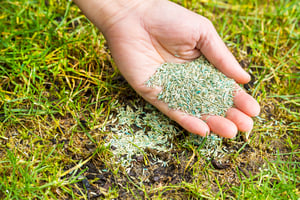 Are you disappointed with how your lawn looks this spring? Do you have bare spots? Harsh winters, insects, animals, and diseases can wreak havoc on your lawn. While I’m not striving for the perfect lawn, I take pride in having a nice, healthy one.
Are you disappointed with how your lawn looks this spring? Do you have bare spots? Harsh winters, insects, animals, and diseases can wreak havoc on your lawn. While I’m not striving for the perfect lawn, I take pride in having a nice, healthy one.
If you’re frustrated with how your lawn looks and you want to fix the bare spots, you can! For existing lawns, lawncare professionals recommend core aeration and over-seeding in the fall. This process promotes overall healthy growth and can help thicken it. However, you can add seed to your lawn in the spring and experience good results.
Here are some tips for fixing your lawn.
1. Determine the best time to plant.
Certain times of the year will generate better results depending on where you live. Cool-season grass seeds will germinate in the Midwest when soil temperatures consistently range between 50 and 65 degrees Fahrenheit. In southern states, warm-season grass seeds will germinate when soil temperatures are between 70 and 80 degrees Fahrenheit.
If the soil temperatures are confusing, a less technical rule of thumb is that grass seed germinates when the air temperature is consistently between 60 and 80 degrees Fahrenheit.
Lastly, if you experience a cool spring or summer, germination may take longer or fail.
2. Prepare the site.
Watering a bare spot will not get the grass to regrow. Site preparation is needed. Before planting the seed, please ensure that weeds, existing grass, sticks, and rocks are removed. After cleaning the area, rough up the soil or lay down some fresh topsoil. The layer of topsoil only needs to be about a quarter inch thick. This allows the seed to connect with the soil. Laying seed on a hard, compact surface won’t work well.
3. Select the appropriate grass seed.
This may seem like a no-brainer. All you need to do is visit your local retail store and buy what’s on their shelves, right? While your local retail store will carry products that contain a mixture of seed that’s appropriate for your area, there are a few things you should consider.
- Does your lawn get full or partial sun?
- Do you have pets?
- Does your lawn get light, moderate, or heavy foot traffic?
For example, Kentucky Bluegrass or Bermudagrass are suitable for heavy-traffic lawns. Perennial Ryegrass is good for light to moderate traffic.
For small areas, I’ve used a product that contains grass seed, mulch, and fertilizer in one, and I've enjoyed success.
4. Determine the correct grade.
For small patch jobs, determining the correct grade isn’t critical. All you need to do is make sure the soil is flat. If you’re reseeding your entire yard, you can do it yourself however, the process is more complicated. Your yard should be graded so that water flows. The last thing you need or want is large mud puddles in your yard or water running towards your home. If you run into trouble, contact your local landscape professional.
5. Apply the seed.
Gently sprinkle the seed on the bare spot until it’s sufficiently covered. You still should be able to see the soil.
6. Water gently.
After you’ve planted your grass seed, briefly and gently water the soil two to five times per day, depending on the temperature. The goal is to keep the soil moist.
7. Don’t get frustrated.
Depending on the type of grass seed you’ve planted, germination can take from 5 to 30 days. If you don’t see acceptable results after 30 days, give the process another try, or consider waiting until fall.
Do you have any suggestions or information you’d like to share? I’d love to hear from you. Please share them in the box below.
Source:
https://www.pennington.com/all-products/grass-seed/resources/the-best-time-to-plant-grass-seed
http://www.garden-counselor-lawn-care.com/watering-new-grass-seed.html





